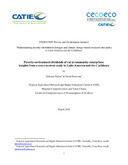| dc.description.abstract | Over the past years, the development of rural community enterprises (RCE) has been advocated as a means to achieve the dual goal of poverty reduction and environmental conservation. However, there is little scientific evidence that RCE are living up to their expectations. Our methodological approach included a questionnaire survey with open-ended and closed questions among RCE stakeholders (general, production and sales managers). Data were triangulated with information obtained from RCE staff other than management, service providers, and downstream enterprises, as well as secondary information. Our main findings are: 1) land tenure is important but not a sine qua non for the initial stages of RCE development; 2) legal forms of RCE typically do not address their realities and needs; 3) some RCE have accumulated considerable physical capital but exhibit low levels of productivity and quality due to limited processing and management skills; 4) participation of women in RCE management and decision making is limited, in particular in the forest sector; 5) RCE tend to be highly undercapitalized irrespective of size and scale; 6) RCE usually take 20 to 40 years to become mature; 7) in many countries, political, legal, and regulatory frameworks are disabling rather than enabling RCE development; 8) long-term accompaniment by public sector agencies and civil society organizations is critical to RCE development, as is a better articulation between technical, business development and financial services; 9) despite overall limitations, most RCE have demonstrated their capacity to generate increased income for their members and, to varying degrees, have had spill-over effects on community development; 10) RCE membership increases the resilience of livelihood strategies of the rural poor, though related asset building may be collective rather than individual in nature; 11) RCE operations tend to be more environmentally benign than those of single-ownership companies; 12) RCE development is not inherently compatible with "triple bottom line" performance; 13) when measuring poverty reduction in mere terms of impact on income, RCE development does not necessarily have an advantage over alternative approaches focusing on agricultural productivity, base-of-the pyramid, or rural-urban migration; and 14) when adopting a broader perspective of poverty reduction, however, RCE development is a competitive approach of ensuring household and community level asset building on the mid and long run. | es_ES |


